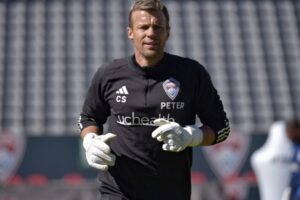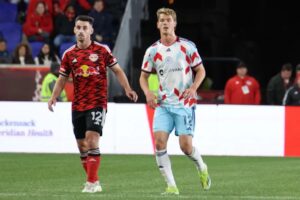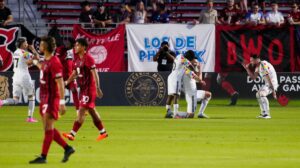Editorial (October 4, 2018) – The United States Men’s National Team qualifying failure for the 2018 World Cup sent shockwaves through the U.S. Soccer community. Blame has usually been directed at people who have spent time at or near the top of the USSF power structure. Perhaps the biggest targets have been then-USSF President Sunil Gulati, then-U.S. coach Bruce Arena, and his predecessor Jurgen Klinsmann. But left unnoted by most in the USMNT’s qualifying failure is that the U.S. player pool was at an unusually low point in 2017, even by U.S. and CONCACAF standards.
USMNT’s qualifying failure was mostly about bad players
While there are any number of valid complaints to be raised about the decisions made by Gulati, Klinsmann, and Arena on the road to the USMNT’s qualifying failure, the talent level of the U.S. player pool hit a historic low point in 2017 with the best players from one generation aging out of international soccer while the next generation of young talented players were still in their teens.
Most prominent is the loss of arguably the two best U.S. outfield players from the 2014 World Cup—Jermain Jones and Clint Dempsey. Among American outfield starters, Jones received top ratings from both MLSsoccer.com (8.0) and WhoScored.com (7.39) for his performance in Brazil, thanks in large part to his beautiful right-footed blast inside the right post against Portugal.
Dempsey, meanwhile, scored in the first minute of the tournament for the U.S. and had to step into the starting center forward’s role after Jozy Altidore suffered an injury in the first game. Dempsey would go on to score the team’s second goal against Portugal, ultimately securing a 2-2 draw that the U.S. would need to advance out of the group stage.
Unfortunately, by the middle of 2017, Jones and Dempsey were approaching the ends of their careers. Dempsey made 29 appearances and scored 12 goals in league play for Seattle, earning MLS Comeback Player of the Year honors, but his age was showing by late summer, and he lost his starting spot with the national team. In the decisive match against Trinidad, Dempsey came on at halftime but didn’t make a significant impact.
Jones declined even faster. He made just 20 appearances with the L.A. Galaxy in 2017, and the club did not pick up his option for the next year. He was out of the USMNT picture by midsummer.
With Jones out of the picture and Dempsey no longer a 90-minute player, the U.S. was left without an abundance of talent to put around teenage sensation Christian Pulisic. Of the ten other starters who took the field with Pulisic, central defender Matt Besler seems like the only one who has sustained a consistent level since the USMNT’s qualifying failure.
Jozy Altidore and Darlington Nagbe can be forgiven for suffering injuries that caused them to miss big chunks of the 2018 season, but while both have played well when fit, neither has stood out as the primary star for his MLS club. That honor would go to Altidore’s teammate Sebastian Giovinco in Toronto and to one of Miguel Almiron or Josef Martinez with Nagbe’s Atlanta United side.
An inglorious supporting cast
Several other starters on that U.S. squad have seen their careers take negative turns in the year since the Trinidad match. Very few have consistently demonstrated the kind of quality fans could reasonably expect from U.S. national team players.
Bobby Wood only scored two goals in 22 league appearances for Hamburg during the 2017-2018 Bundesliga season and has yet to score in four league appearances since joining Hannover on loan for the current season.
Michael Bradley contributed to Toronto FC’s run deep into the CONCACAF Champions League early this year, but he has captained Toronto to an abysmal 15 losses in 30 league matches, good for ninth out of 11 teams in the MLS Eastern Conference. Along the way, Bradley hasn’t been named to a single MLS Team of the Week in 2018.
Omar Gonzalez, infamous now for his own-goal against Trinidad, has moved from Pachuca to Atlas, where he is starting regularly for the team at the bottom of the Liga MX table, with just one win in 11 matches.
Jorge Villafana returned to Portland this summer from reigning Liga MX Clausura champions Santos Laguna in what most would consider a step down in competition. Like Bradley, Villafana has not been named to a single MLS Team of the Week since rejoining Portland in early August.
Paul Arriola was recognized as among the best 11 in week 20 of this MLS season, but he has been relegated to something of a utility role at times for DC United. He remains unquestionably below teammates Wayne Rooney and Luciano Acosta in the pecking order at the club, which remains just outside the Eastern Conference playoff spots (though with high hopes of moving up).
Deandre Yedlin continues to develop in a starting role for Newcastle near the bottom of the English Premier League. If you believe Taylor Rockwell and Daryl Grove of the Total Soccer Show podcast (you probably should), Yedlin remains the first choice for the U.S. at right-back, but he continues to frustrate fans of club and country alike, most recently with an avoidable handball in the penalty area against Leicester.
And then there’s Tim Howard, who didn’t cover himself in glory against Trinidad and seems squarely outside of the U.S. picture less than a year later. This may be about age, or it may be about the 54 goals he has allowed in 29 appearances for Colorado this season.
The next generation is still mostly boys
Pulisic’s star had already begun to shine by October of last year, but Timothy Weah, Weston McKennie, and Josh Sargent—all bright future prospects for the U.S.—were still several months away from playing professional first-team football.
Tyler Adams had begun to make an impact for the New York Red Bulls, but was still only 18 and second-fiddle to Sasha Kljestan in the center of the Red Bulls midfield. Matt Miazga, similarly, was earning minutes on loan from Chelsea to Dutch side Vitesse but was still too shaky to be trusted in the middle of the U.S. defense.
Similar statements can be made about young defenders Cameron Carter-Vickers and Antonee Robinson, a couple of athletic young guys on loan from Premier League clubs.
This failure was no orphan
The late president John F. Kennedy once famously quipped, “Victory has a hundred fathers, and defeat is an orphan.” In this case, the USMNT’s qualifying failure had no shortage of fathers. Sure, Gulati, Klinsmann, and Arena all played their parts, and there’s no telling what might have happened if John Brooks had been fit or if Geoff Cameron had been selected over Gonzalez.
But it seems fair to say that in 2017 the U.S. player pool was as bad as it has been since the 1990s. Consider the 2006 team that disappointed in Germany. That squad had Landon Donovan, Demarcus Beasley, and Carlos Bocanegra in their primes. It had a pre-injury Oguchi Onyewu who was starring in Belgium with Standard Liege and would eventually earn a contract with AC Milan.
Brian McBride was approaching the end of his career but would go on to appear 38 times for Fulham in the Premier League the next season. That 2006 U.S. team was even deep enough to bring a 23-year-old Dempsey off the bench. Any of those players would have been easy selections over the guys who played their positions against Trinidad—and that more-talented U.S. team managed just one draw and two losses before crashing out of the 2006 World Cup.
It’s easy to argue that even a not-very-talented U.S. team should still have beaten Trinidad and Tobago a year ago, and that may be so. But it’s not unusual for mediocre players to get upset on the road in crazy weather, and while Gulati, Arena, and Klinsmann may deserve a lot of the vitriol that has been sent their way, this seems like one of those situations where the simplest answer is the best one: The players played poorly because most of them weren’t very good.






